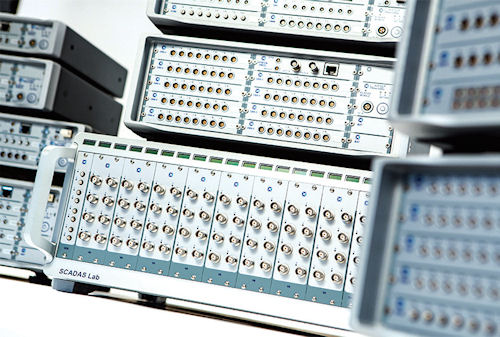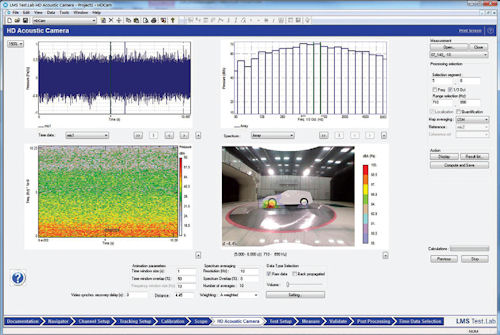Latest News
November 1, 2013
Saying it’s the first product lifecycle management (PLM) software company to provide a closed-loop, systems-driven product development solution with integrated test, Siemens had a strong rationale for its acquisition of LMS, according to Bruno Massa, vice president of the Test Division, LMS, A Siemens Business.
“There is a very strong complementarity between their solutions and our solutions. That’s obviously true for the simulation side of things,” says Massa. “There is almost no overlap between their tools and our tools.”
On the simulation side, Siemens had focused on finite element analysis (FEA)—with NX product design software as one example. In contrast, LMS focused on specific performance attribute domains, such as acoustic simulations—for example, ride and handling simulations and vehicle energy management in automotive applications. As a result, there is a natural fit between these portions of the two businesses.
Test provided another key piece of the technology puzzle, Massa explains: “The test part plays an important role in Siemens’ strategy because Siemens wants to evolve in the future toward a tool-centered solution set that not only allows the virtual world type of validation, but also to do that with a closed loop to the real world.”
Because test was at the core of the LMS strategy, the combination of the two companies made the fit even better, he adds.
The Testing Approach
Unlike simulation software, test starts with actual hardware—a vehicle, for example. “Typically, we do not start with a CAD model or an FE model,” Massa says. “We start from the real thing, a prototype, a basic touchable part.”
As seen in Fig. 1, the team instruments the vehicle with “all kinds of sensors,” including a microphone, vibration sensors and strain sensors, he adds. The sensors connect to the LMS SCADAS data acquisition system. This hardware provides the first digital treatment of the sensor signals, and then transfers that information to Test.Lab. The software-based testing system performs further treatment of the signals—including time synchronization and proper visualization of the data for users. It also provides a broad range of analysis tools to understand the root cause and source of noise and/or vibration (see Fig. 2).
 Fig 1: Testing the acoustic characteristics of an electric vehicle involves traditional road noise and wind noise, as well as high frequencies generated by the inverters used to control the power of AC motors through pulse width modulation. |
“All that chain of activity is quite independent from any CAD environment or simulation environment,” says Massa. “You don’t need simulation or CAD tools to do that job.”
In addition, testing can involve a prototype that is in its final validation/verification stage before sign-off for production. If there are performance aspects that do not meet the targeted requirements, the purpose of the test will be troubleshooting to refine and further correct the prototype, and determine the required design changes.
Another end purpose for test is quite different, and involves simulation. In this case, the testing is performed to capture information from a real vehicle—perhaps a predecessor vehicle or a benchmark vehicle so the information can be fed back into simulation models.
 Fig 2: A dual-channel LMS SCADAS FR4 Flexray module and a four-channel LMS SCADAS DCH4 module for high temperatures are new data acquisition modules in LMS Test.Lab Rev 13. |
“It’s to take out some uncertainties in your 3D or simplified simulation models, to basically calibrate and validate your models,” Massa explains. “With further refinements of the design using 3D models, you can basically work with validated assumptions from the real world.”
The models can be component, or subsystem levels such as a suspension or vehicle body. It can even be a full vehicle. In applications like automotive, Massa says, there is an increasingly tight link between these two roles.
New Systems Requirements
Today’s vehicles have created new system requirements—as well as the need for more comprehensive testing, especially acoustic testing. The lack of engine noise in electric vehicles, and hybrid vehicles when they operate only on electric power, reveals acoustic noise that was normally masked. Road noise, the connection between the tires and the road, and wind noise, especially at higher vehicle speeds, are two common noise sources.
LMS’ Test.Lab Transfer Path Analysis (TPA) technology allows users to investigate the relationship between the noise level that a driver would experience in a vehicle to determine whether it is. TPA traces the flow of vibro-acoustic energy from a source, through a set of known structure- and air-borne transfer pathways, to a given receiver location.
“Today, the technology that we have developed and also extended in Revision 13 allows us to understand and investigate what the real source of the noise issue can be,” Massa says. He notes it can also assist in determining what to modify to reduce or eliminate any noise problems.
 Fig 3: The data from high-definition acoustic cameras allows the precise location of the origin of various sounds. |
Revision 13 of LMS Test.Lab combines classical frequency-based and time-domain TPA measurements with pass-by noise (PBN) measurements (as defined by ISO 362, with required limits regulated by various governmental bodies) to allow engineers to easily analyze which subsystems contribute most to the total noise level, relative to the vehicle position. With this approach, all interior or exterior PBN measurements can be finalized within just two days (see Fig. 3).
New Systems Capabilities
The Sound Source Localization tool added to Test.Lab Rev 13 provides a 3D visual representation of the sound in the vehicle. During vehicle testing, this allows on-the-spot investigation of where leakages are occurring in the interior—through the heating, ventilation and air-conditioning (HVAC) system, stereo speakers, door and window seals or other openings.
“These are tools that allow users to accelerate the testing—and specifically the conclusion you can take from a test—and bring that at the same exact moment while you are physically performing your test on the vehicle,” Massa explains. “You no longer have to wait a couple of hours, or worst case, a couple of days or weeks to come to an end conclusion of what’s good or wrong with your vehicle.”
Another key aspect of Test.Lab Rev 13 involves data management. According to Massa, the new solution ensures that users don’t “just create and generate large volumes of data, but that they also have a structured solution inside their Test.Lab product to manage the data, and can easily search results, distribute results, create reports and make those reports available.”
Taking Test to a New Level
Indications of closer linkage with Siemens are quite clear, but the how and when are yet to be announced.
“Siemens has a clear direction of not just acquiring a company, but also from the tools perspective, to have integration and further cross-links between the solutions,” says Massa.
For now, the new capabilities in Test.Lab Rev 13 bode well for tighter linkages in future software solutions.
Randy Frank is a contributor to DE. Send e-mail about this article to [email protected].
More Info
Subscribe to our FREE magazine, FREE email newsletters or both!
Latest News
About the Author
Randy FrankRandy Frank is a freelance technology writer based in Arizona. Contact him via [email protected].
Follow DE





